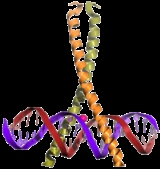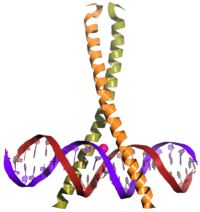
CREB
Encyclopedia

Transcription factor
In molecular biology and genetics, a transcription factor is a protein that binds to specific DNA sequences, thereby controlling the flow of genetic information from DNA to mRNA...
. It binds to certain DNA
DNA
Deoxyribonucleic acid is a nucleic acid that contains the genetic instructions used in the development and functioning of all known living organisms . The DNA segments that carry this genetic information are called genes, but other DNA sequences have structural purposes, or are involved in...
sequences called cAMP response elements (CRE), thereby increasing or decreasing the transcription
Transcription (genetics)
Transcription is the process of creating a complementary RNA copy of a sequence of DNA. Both RNA and DNA are nucleic acids, which use base pairs of nucleotides as a complementary language that can be converted back and forth from DNA to RNA by the action of the correct enzymes...
of the downstream gene
Gene
A gene is a molecular unit of heredity of a living organism. It is a name given to some stretches of DNA and RNA that code for a type of protein or for an RNA chain that has a function in the organism. Living beings depend on genes, as they specify all proteins and functional RNA chains...
s.
CREB was first described in 1987 as a cAMP-responsive transcription factor regulating the somatostatin gene.
Genes whose transcription is regulated by CREB include: c-fos
C-Fos
In the field of molecular biology and Genetics, c-Fos is a protein encoded by the FOS gene.-Structure and function:c-Fos is a cellular proto-oncogene belonging to the immediate early gene family of transcription factors. c-Fos has a leucine-zipper DNA binding domain, and a transactivation domain at...
, the neurotrophin
Neurotrophin
Neurotrophins are a family of proteins that induce the survival, development, and function of neurons.They belong to a class of growth factors, secreted proteins that are capable of signaling particular cells to survive, differentiate, or grow. Growth factors such as neurotrophins that promote the...
BDNF (Brain-derived neurotrophic factor), tyrosine hydroxylase
Tyrosine hydroxylase
Tyrosine hydroxylase or tyrosine 3-monooxygenase is the enzyme responsible for catalyzing the conversion of the amino acid L-tyrosine to dihydroxyphenylalanine . It does so using tetrahydrobiopterin as a coenzyme. DOPA is a precursor for dopamine, which, in turn, is a precursor for norepinephrine ...
, and many neuropeptide
Neuropeptide
Neuropeptides are small protein-like molecules used by neurons to communicate with each other. They are neuronal signaling molecules, influence the activity of the brain in specific ways and are thus involved in particular brain functions, like analgesia, reward, food intake, learning and...
s (such as somatostatin
Somatostatin
Somatostatin is a peptide hormone that regulates the endocrine system and affects neurotransmission and cell proliferation via interaction with G-protein-coupled somatostatin receptors and inhibition of the release of numerous secondary hormones.Somatostatin...
, enkephalin
Enkephalin
An enkephalin is a pentapeptide involved in regulating nociception in the body. The enkephalins are termed endogenous ligands, or specifically endorphins, as they are internally derived and bind to the body's opioid receptors. Discovered in 1975, two forms of enkephalin were revealed, one...
, VGF
VGF
VGF or VGF nerve growth factor inducible is a protein and neuropeptide that may play a role in regulating energy homeostasis, metabolism and synaptic plasticity. The protein was first discovered in 1985 by Lewi et al. in an experiment with PC12 cells and its name is non-acronymic...
, and corticotropin-releasing hormone
Corticotropin-releasing hormone
Corticotropin-releasing hormone , originally named corticotropin-releasing factor , and also called corticoliberin, is a polypeptide hormone and neurotransmitter involved in the stress response...
).
CREB is closely related in structure and function to CREM (cAMP response element modulator) and ATF-1 (activating transcription factor-1) proteins. CREB proteins are expressed in many animals, including humans.
CREB has a well-documented role in neuronal plasticity
Neuroplasticity
Neuroplasticity is a non-specific neuroscience term referring to the ability of the brain and nervous system in all species to change structurally and functionally as a result of input from the environment. Plasticity occurs on a variety of levels, ranging from cellular changes involved in...
and long-term memory
Long-term memory
Long-term memory is memory in which associations among items are stored, as part of the theory of a dual-store memory model. According to the theory, long term memory differs structurally and functionally from working memory or short-term memory, which ostensibly stores items for only around 20–30...
formation in the brain.
Subtypes
The following genes encode CREB or CREB-like proteins:- CREB1CREB1CAMP responsive element binding protein 1, also known as CREB-1, is a protein that in humans is encoded by the CREB1 gene. This protein binds the cAMP response element, a DNA nucleotide sequence present in many viral and cellular promoters...
- CREB2 renamed ATF4ATF4Activating transcription factor 4 , also known as ATF4, is a protein that in humans is encoded by the ATF4 gene.- Function :...
- CREB3CREB3Cyclic AMP-responsive element-binding protein 3 is a protein that in humans is encoded by the CREB3 gene.-Interactions:CREB3 has been shown to interact with Host cell factor C1.- External links :...
- CREB5CREB5Cyclic AMP-responsive element-binding protein 5 is a protein that in humans is encoded by the CREB5 gene.-Further reading:...
- CREB3L1
- CREB3L2
- CREB3L3
- CREB3L4
Mechanism of action
A typical (albeit somewhat simplified) sequence of events is as follows: A signal arrives at the cell surface, activates the corresponding receptor, which leads to the production of a second messenger such as cAMP or Ca2+Calcium
Calcium is the chemical element with the symbol Ca and atomic number 20. It has an atomic mass of 40.078 amu. Calcium is a soft gray alkaline earth metal, and is the fifth-most-abundant element by mass in the Earth's crust...
, which in turn activates a protein kinase
Protein kinase
A protein kinase is a kinase enzyme that modifies other proteins by chemically adding phosphate groups to them . Phosphorylation usually results in a functional change of the target protein by changing enzyme activity, cellular location, or association with other proteins...
. This protein kinase translocates to the cell nucleus
Cell nucleus
In cell biology, the nucleus is a membrane-enclosed organelle found in eukaryotic cells. It contains most of the cell's genetic material, organized as multiple long linear DNA molecules in complex with a large variety of proteins, such as histones, to form chromosomes. The genes within these...
, where it activates a CREB protein. The activated CREB protein then binds to a CRE region, and is then bound to by a CBP (CREB-binding protein), which coactivates it, allowing it to switch certain genes on or off. The DNA binding of CREB is mediated via its basic leucine zipper domain (bZIP domain
BZIP domain
The Basic Leucine Zipper Domain is found in many DNA binding eukaryotic proteins. One part of the domain contains a region that mediates sequence specific DNA binding properties and the leucine zipper that is required for the dimerization of two DNA binding regions. The DNA binding region...
) as depicted in the picture.
Function
CREB has many functions in many different organs, however most of its functions have been studied in relation to the brain. CREB proteins in neuronNeuron
A neuron is an electrically excitable cell that processes and transmits information by electrical and chemical signaling. Chemical signaling occurs via synapses, specialized connections with other cells. Neurons connect to each other to form networks. Neurons are the core components of the nervous...
s are thought to be involved in the formation of long-term memories; this has been shown in the marine snail Aplysia
Aplysia
Aplysia is a genus of medium-sized to extremely large sea slugs, specifically sea hares, which are one clade of large sea slugs, marine gastropod mollusks. The general description of sea hares can be found in the article on the superfamily Aplysioidea....
, the fruit fly Drosophila melanogaster
Drosophila melanogaster
Drosophila melanogaster is a species of Diptera, or the order of flies, in the family Drosophilidae. The species is known generally as the common fruit fly or vinegar fly. Starting from Charles W...
, and in rats (see CREB in Molecular and Cellular Cognition
CREB in Molecular and Cellular Cognition
- CREB and the stability of memory :There is a great deal of evidence that CREB has a role in the molecular steps that stabilize memory in the brain. This evidence includes CREB manipulations in several learning paradigms across multiple brain regions and multiple species. For example, there is...
). CREB is necessary for the late stage of long-term potentiation
Long-term potentiation
In neuroscience, long-term potentiation is a long-lasting enhancement in signal transmission between two neurons that results from stimulating them synchronously. It is one of several phenomena underlying synaptic plasticity, the ability of chemical synapses to change their strength...
. CREB also has an important role in the development of drug addiction. There are activator and repressor forms of CREB. Flies genetically engineered to overexpress the inactive form of CREB lose their ability to retain long-term memory. CREB is also important for the survival of neurons, as shown in genetically engineered mice, where CREB and CREM were deleted in the brain. If CREB is lost in the whole developing mouse embryo, the mice die immediately after birth, again highlighting the critical role of CREB in promoting survival.
Disease linkage
Disturbance of CREB function in brain can contribute to the development and progression of Huntington's DiseaseHuntington's disease
Huntington's disease, chorea, or disorder , is a neurodegenerative genetic disorder that affects muscle coordination and leads to cognitive decline and dementia. It typically becomes noticeable in middle age. HD is the most common genetic cause of abnormal involuntary writhing movements called chorea...
. Abnormalities of a protein that interacts with the KID domain of CREB, the CREB-binding protein, (CBP) is associated with Rubinstein-Taybi syndrome
Rubinstein-Taybi syndrome
Rubinstein-Taybi Syndrome , also known as broad thumb-hallux syndrome or Rubinstein syndrome, is a condition characterized by short stature, moderate to severe learning difficulties, distinctive facial features, and broad thumbs and first toes. Other features of the disorder vary among affected...
. CREB is also thought to be involved in the growth of some types of cancer.
cAMP response element
The cAMP response element is the response element
Response element
Response elements are short sequences of DNA within a gene promoter region that are able to bind a specific transcription factor and regulate transcription of genes.-Examples:Examples of response elements include:*Hormone response element...
for CREB. Since the effects of protein kinase A on the synthesis of proteins work by activating CREB, the cAMP response element is responsible for modulating the effects of protein kinase A that work by protein synthesis.
External links
- Johannessen, M., Pedersen Delghandi, M., and Moens, U. (2004) - What Turns CREB on ? - Cell Signall.; 10:1211-1227. http://www.sigtrans.org/publications/what-turns-creb-on/
- http://focus.hms.harvard.edu/2001/Oct26_2001/neuroscience.html
- Drosophila Cyclic-AMP response element binding protein A - The Interactive Fly
- Drosophila Cyclic-AMP response element binding protein B at 17A - The Interactive Fly

